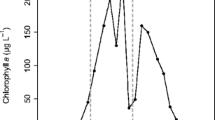Abstract
The transport of organic matter from the water column to the sediment and the relationship between the dynamics of the settleable fraction and that of the total suspended particulate matter were studied in shallow eutrophic Lake Wingra, Wisconsin. Tripton sedimentation was closely related to the dynamics of seston with a lag of 2 to 4 weeks. Sedimentation rate of tripton ranged from 0 to 8 g m−2 day−1 (in May and August respectively). Relative t0 the standing crop 0f seston the maximum sedimentation rate was 8% seston per day (in September). The annual tripton sedimentation was estimated at 632 g dry weight or 215 g C per m2 which was equivalent t0 55% of the annual phytoplankton production and 42% of the phytoplankton and macrophytes annual production. It was estimated that 70% of the settling organic matter is decomposed annually, consequently only a small fraction 0f tripton is involved in the long term accumulation of bottom deposits. Factors influencing tripton sedimentation are discussed.
Similar content being viewed by others
References
Abernathy, A. R. & Bungay, H. R. 1972. Water quality predictions based on limnological parameters. Water Resources Research Institute, Clemson University, Clemson, South Carolina. Rep. No. 32: 163 p.
Adams, M. S. & McCracken, M. D. 1974. Seasonal production of the Myriophyllum component of the littoral of Lake Wingra, Wisconsin. J. of Ecology 62 (2): 487–495.
Bortleson, G. C. 1970. The chemical investigation of recent lake sediments from Wisconsin lakes and their interpretation. PhD thesis. University of Wisconsin. 259 p.
Darnell, R. M. 1961. Trophic spectrum of an estuarine community based on studies of Lake Pontchartrain, Louisiana. Ecology 42: 553–568.
Darnell, B. M. 1964. Organic detritus in relation to secondary production in aquatic communities. Ver. Internat. Verein. Limnol. 15: 462–470.
Davis, M. B. 1968. Pollen grains in lake sediment, redeposition caused by seasonal water circulation. Science. 162: 796–799.
Gasith, A. 1974. Allochthonous organic matter and organic matter dynamics in Lake Wingra Wisconsin. PhD thesis. University of Wisconsin, Madison. 209 p.
Gasith, A. 1975. Tripton sedimentation in eutrophic lakes, simple correction for the resuspended matter. Verb. Internat. Verein. Limnol. 19: 116–122.
Jewell, W. J. & McCarty, P. L. 1971. Aerobic decomposition of algae. Environ. Sci. Tech. 5 (10): 1023–1031.
Johnson, M. G. & Brinkhurst, R. O. 1971. Benthic community metabolism in bay of Quinte and Lake Ontario. J. Fish. Res. Bd. Canada 28 (11): 1715–1725.
Jonasson, P. M. 1964. The relationship between primary production and production of profandal bottom invertebrates in a Danish eutrophic lake. Verh. Internat. Verein. Limnol. 15: 471–479.
Koonce, J. F. 1972. Phytoplankton succession and a dynamic model of algal growth and nutrient uptake. PhD thesis. University of Wisconsin. 192 p.
Lawacz, W. 1969. The characteristics of sinking materials and the formation of bottom deposits in a eutrophic lake. Mitt. Internat. Verein. Limnol. 17: 319–331.
Mackereth, F. J. H. 1966. Some chemical observation on postglacial lake sediments. Phi. Trans. R. Soc. B. 250: 165–213.
Pennington, W. 1974. Seston and sediment formation in five Lake District lakes. J. Ecol. 62 (1): 215–251.
Rich, P. H. 1970. Utilization of benthic detritus in a marl lake. PhD thesis. Michigan State University. 78 p.
Ruttner, F. 1953. Fundamentals of Limnology. Univ. of Toronto press. 292 p.
Serruya, C. 1973. Sediments in Lake Kinneret data record. In: Lake Kinneret data record, T. Berman (Ed.), N.C.R.D. 13–73, Israel: 39–46.
Steele, J. H. & Baird, I. E. 1972. Sedimentation of organic matter in a Scottish sea loch. Mem. Inst. Ital. Idrobiol. 29 suppl.: 73–88.
Tutin, W. 1955. Preliminary observations on a year's cycle of sedimentation in Windermere, England.
Wetzel, R. G., Rich, P. H., Miller, M. C. & Allen, H. L. 1972. Metabolism of dissolved and particulate detrital carbon in a temperate hard water lake. Mem. Ist. Ital. Idrobiol. Suppl. 29: 185–243.
Author information
Authors and Affiliations
Additional information
Research supported by the Eastern Deciduous Forest Biome US-IBP, funded by the National Science Foundation under Interagency Agreement AG-199 BMS69-01147 A09 with the Energy Research and Development Administration-Oak Ridge National Laboratory. Contribution N0. 233 from the Eastern Deciduous Forest Biome US-IBP.
Research supported by the Eastern Deciduous Forest Biome US-IBP, funded by the National Science Foundation under Interagency Agreement AG-199 BMS69-01147 A09 with the Energy Research and Development Administration-Oak Ridge National Laboratory. Contribution N0. 233 from the Eastern Deciduous Forest Biome US-IBP.
Rights and permissions
About this article
Cite this article
Gasith, A. Seston dynamics and tripton sedimentation in the pelagic zone of a shallow eutrophic lake. Hydrobiologia 51, 225–231 (1976). https://doi.org/10.1007/BF00005748
Received:
Issue Date:
DOI: https://doi.org/10.1007/BF00005748




